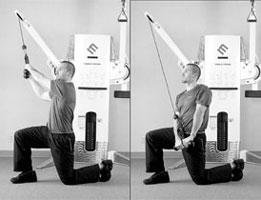 Ever try to walk or run on ice? What happens? You brace or tense up to create extra stability throughout your body in an attempt to survive.
So here's a question: How well can you walk, run, or otherwise move when your body is in lockdown mode? Here's the answer: not very.
Ever try to walk or run on ice? What happens? You brace or tense up to create extra stability throughout your body in an attempt to survive.
So here's a question: How well can you walk, run, or otherwise move when your body is in lockdown mode? Here's the answer: not very.
Quick functional anatomy 101 lesson. Under normal conditions you've got muscles dedicated to moving your body and you've got muscles dedicated to stabilizing your body. The dedicated stabilizers are located directly around joints and work 'behind the scenes' so that you can effortlessly stand on one leg, for example.
When your dedicated mover muscles (think quads, hamstrings, calves, glutes, etc) pull double duty by acting as movers AND stabilizers, you'll feel tight and restricted. Think back to the ice running example above.
The problem many people have is that on some level their brain thinks they're always on ice. Authentic stability has been lost and well, since you're going running anyway, the body will compensate to allow that.
The compensation is to tighten up your dedicated mover muscles and turn them into stabilizers. Once this happens for a prolonged period of time, you will effectively train those particular muscles to always be “on”. That is, they are contracting to stabilize you – even at rest!
This is called neurologic tightness because it's your nervous system that is creating the tightness. The muscle is fine. Long as ever. Unfortunately, it is contracting because the brain has learned that the body will be vulnerable to injury if it relaxes the tensed muscle.
How's your deep squat looking?
The rectus femoris is a muscle that always seems tight with a lot of folks. Why is this? Well, if your deep core and deep hip stabilizers aren't doing their job, then your body will seek stability from somewhere else. Basically, your quads become your core. Not good.
Compare two people performing a squat. One has nice, reflexive core stability and is comfortable in a deep squat. He is upright, balanced, and can hang out there for awhile.
The other guy pitches forward with his head well in front of his knees. If he drops his butt any lower, he'll topple backwards. It is really taxing to hang out in a deep squat position because he doesn't have authentic stability in the squat pattern.
Bottom line: if you possess good movement patterns, your stability system is working well and you won't be as prone to neurologic tightness.
Short Muscles Vs. Tight Muscles
If you learn nothing else today, remember this: a short muscle is physically short while a tight muscle behaves like it's short because it's actually contracting. Short muscles are less common and a religious stretching program must be followed, but I'm betting that's not your problem.
If you're always relying on your quads for stability rather than your deep core, then of course, over time, they will get tight. They are contracting all the time, ready to stabilize.
What's the fix?
 So should we just think about our core more? No. I think that's already a problem – too much thinking. You need reflexive stability, not more thinking and tightening.
So should we just think about our core more? No. I think that's already a problem – too much thinking. You need reflexive stability, not more thinking and tightening.
I'm not going to go into too much depth here, but there are 3 steps to reduce neurologic tightness.
- Get the muscle to relax. Gently and slowly use a foam roller or do some contract-relax stretching. You've got to let your nervous system know that it's OK to just. let. go.
- Teach the body how to move properly without the parking brake on by doing a mobility drill immediately after step 1.
- Lock in the change by performing a stability drill. Skip this step and your tightness will come back over and over again.
Here's a concrete example for the tight hip flexor person described above.
- Foam roll the full length of the middle quad all the way up to near the pelvic bone. This releases the tension. Be sure to move at a GLACIAL PACE with the roller.
- Teach the hip that it is ok to move without the parking brake on. Do this mobility drill.
- Perform a half-kneeling cable chop with strict form. Great video here. This will improve your core stability – which is the root of your problem!
Remember, if you want to get rid of tightness, you need to figure out why the muscle is tight. The #1 cause is stress. Today you learned about the #2 cause of tightness: neurologic tightness. To find out if you're running around with the parking brakes on, consult a skilled fitness professional or rehab specialist.


